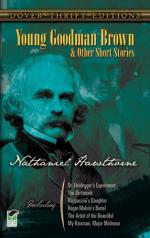|
This section contains 2,066 words (approx. 7 pages at 300 words per page) |

|
SOURCE: “Lachrymal Imagery in Hawthorne's ‘Young Goodman Brown,’” in Studies in Short Fiction, Vol. 28, No. 3, Summer, 1991, pp. 339-43.
In the following essay, Easterly discusses Hawthorne's use of lachrymal, or tear, imagery in “Young Goodman Brown,” emphasizing Brown's inability to cry either out of sorrow for others or in repentance for his own sins.
“Faith! Faith!” cried the husband. “Look up to Heaven, and resist the Wicked One!”
Whether Faith obeyed, he knew not. Hardly had he spoken, when he found himself amid calm night and solitude, listening to a roar of the wind, which died heavily away through the forest. He staggered against the rock and felt it chill and damp, while a hanging twig, that had been all on fire, besprinkled his cheek with the coldest dew.
(Hawthorne [“Young Goodman Brown”] 88)
Thus ends the crucial scene in Nathaniel Hawthorne's tale of “Young Goodman Brown,” the story of...
|
This section contains 2,066 words (approx. 7 pages at 300 words per page) |

|


